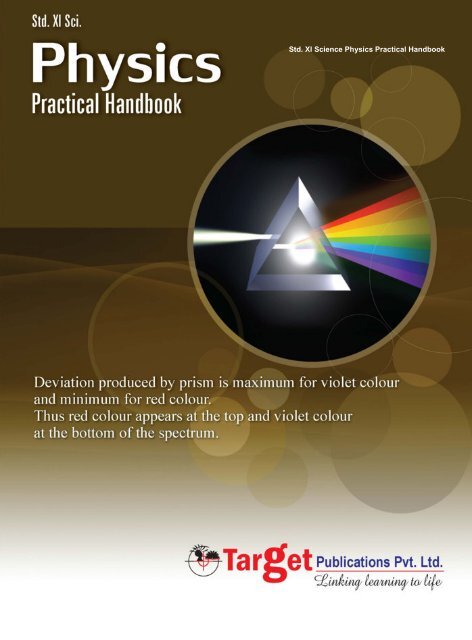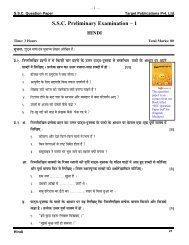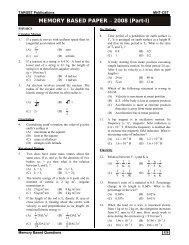Physics Practical Handbook: Std. 11 Science - Target Publications
Physics Practical Handbook: Std. 11 Science - Target Publications
Physics Practical Handbook: Std. 11 Science - Target Publications
Create successful ePaper yourself
Turn your PDF publications into a flip-book with our unique Google optimized e-Paper software.
PREFACE<strong>Physics</strong> has played a major role in the development of science and technology during the years. Itcovers a wide range of phenomena, from the smallest sub-atomic particles to the largest galaxies. Itis the study of matter and energy and the interaction between them. <strong>Practical</strong> physics has applicationsin the fields of engineering, medicine, technology etc. In practical physics the student obtainlaboratory skills, design experiments and apply instrumentation such as electronic circuits to observeand measure natural phenomena.To master the science of physics practical one needs to have a complete and thorough knowledge ofall the experiments involved. Hence we bring to you “<strong>Std</strong>. XI Sci. : PHYSICS PRACTICALHANDBOOK” which covers all the experiments of <strong>Std</strong> XI. This handbook is writtern according tothe syllabus. It includes different sets of experiments with proper steps and neat and labelleddiagrams. These experiments help the student to understand the practical applications of manyprinciples and laws involved in <strong>Std</strong>. XI. The handbook also includes all the useful tables given at theend.And lastly, we would like to thank all those who have helped us in preparing this book. There isalways room for improvement and hence we welcome all suggestions and regret any errors that mayhave occurred in the making of this book.A book affects eternity; one can never tell where its influence stops.Best of luck to all the aspirants!Your’s faithfullyPublisher
TARGET <strong>Publications</strong>Use of Vernier Callipers01USE OF VERNIER CALLIPERSEXPERIMENTAim:i. To find the volume of a sphere andii. To find volume of a hollow cylinder, by using vernier callipers.Apparatus:Vernier callipers, sphere, hollow cylinder.Diagram:P′Q′Main Scale (cm)0 123 4 5 6 7 8PQVernier scaleSphere/CylinderVernier callipersDiagram - 100125 10Main ScaleVernier scale(a)No zeroerror0Main scale0 5Vernier scaleDiagram - 2101 cm(b)Negativezero error00Main scale5Vernier scale101 cmDiagram - 3<strong>Std</strong>. XI Sci. : <strong>Physics</strong> <strong>Practical</strong> <strong>Handbook</strong> 1
TARGET <strong>Publications</strong>Use of Vernier Callipers0Main scale1 cmFormula:(c)Positivezero error05Vernier scaleDiagram - 410i. Volume of a sphere =ii.4 r33 πWhere ‘r’ is radius of sphereVolume of cylinder = πR 2 hWhere ‘R’ is radius of cylinder and ‘h’ is height of cylinder.Procedure:i. Note down the value of one division of main scale (X) and number of divisions on vernierscale (N). Hence find out least count of vernier callipers (See diagram - 1).ii. Find zero error of vernier callipers (See diagrams 2, 3, 4).iii. To measure the diameter and hence radius of sphere, place the given sphere between the twojaws of the vernier callipers. Care should be taken that undue pressure on the sphere isiv.avoided.Observe the zero of the vernier scale. It lies between two successive readings of the mainscale. The lesser reading is the main scale reading (M.S.R.) ‘a’v. Now count the division of vernier scale which coincides with any of the division of main scale.This coinciding division of vernier scale is vernier scale division (V.S.D.) ‘n’. Multiply ‘n’ byleast count of vernier callipers to obtain the value of vernier scale reading. This is ‘b’ and it isb = n × least count.vi. The total reading is the sum of main scale reading ‘a’ and vernier scale reading ‘b’. This totalreading gives the diameter of the sphere.vii. Repeat the procedure (iv) to (vi) five times by rotating the sphere to get diameter at differentplaces. Hence mean diameter and radius can be found out.viii. Place the cylinder between the two jaws of the vernier callipers. Repeat the procedure (iv) to(vii). Find out inner diameter and hence radius of the cylinder.ix. Measure the height of the cylinder by meter scale.x. Apply zero correction due to zero error for every reading.Observations:i. Value of the smallest division on main scale (X) = ……….. cmii. Number of divisions on vernier scale (N) = ………… divLeast count of vernier callipers, L.C. = X N = ……….iii.Height of the cylinder = …………. cm<strong>Std</strong>. XI Sci. : <strong>Physics</strong> <strong>Practical</strong> <strong>Handbook</strong> 2
TARGET <strong>Publications</strong>Use of Vernier CallipersObservation table:ObjectObs.No.M.S.R.‘a’(cm)V.S.D.n(div.)V.S.R.b = n × L.C.(cm)Total reading(a + b)(cm)Correctedreading(cm)1.2.Sphere3.4.5.1.2.Cylinder3.4.5.Calculations:i. Corrected mean diameter of sphere = d = …………. cm∴Radius of sphere = r = d 2= …………. cmii.Corrected mean inner diameter of cylinder = D = …………. cm∴Radius of cylinder = R = D 2= …………. cmiii. Volume of sphere = V = 4 3 π r3 = ………… cm 3iv. Volume of cylinder = V′ = π R 2 h = ………… cm 3Result:i. Volume of sphere = ……….. cm 3ii. Volume of cylinder = ………….. cm 3<strong>Std</strong>. XI Sci. : <strong>Physics</strong> <strong>Practical</strong> <strong>Handbook</strong> 3
TARGET <strong>Publications</strong>Use of Vernier CallipersPrecautions:i. While holding object in the jaws, do not exert undue pressure on it. The jaws should just touchthe object.ii. Take number of readings at different positions of the sphere as well as cylinder.iii. The upper jaws should just touch the inner diameter of hollow cylinder.iv. The coinciding division of vernier scale should be taken accurately, if required magnifyingglass can be used.Space for calculation:<strong>Std</strong>. XI Sci. : <strong>Physics</strong> <strong>Practical</strong> <strong>Handbook</strong> 4
TARGET <strong>Publications</strong>02Use of Micrometer screw gaugeUSE OF MICROMETER SCREW GAUGEEXPERIMENTAim:i. To measure the diameter of a wire by using micrometer screw gauge.ii. To measure the thickness of a metal glass plate by using micrometer screw gauge.Apparatus:Micrometer screw gauge, wire and metal plate or glass plate etc.Diagram:Projecting cylindricalmetal piece (Anvil)Circular ScaleMain ScaleNutSleeveThimbleObjectSpindleReference lineRatchetU-Shaped metal frameDiagram - 1Reference lineDiagram - 20No zero errorReference lineDiagram - 3090Negative zero errorReference lineDiagram - 4100Positive zero error<strong>Std</strong>. XI Sci. : <strong>Physics</strong> <strong>Practical</strong> <strong>Handbook</strong> 5
TARGET <strong>Publications</strong>Formula:Cross-sectional area of wire A = πr 2Where r = radius of cross section of wire.Use of Micrometer screw gaugeProcedure:i. Find out the distance (X) through which screw travels on the main scale in five rotations of thecircular scale. Hence distance travelled by the circular scale in one rotation is called the pitchof the screw.ii. Note down the number of divisions on the circular scale. Hence knowing pitch, L.C. (Leastcount) of the screw can be determined (See diagram - 1).iii. Find out zero error of micrometer screw. This can be found out as follows:When the two jaws of micrometer screw gauge are brought in contact with each other withoutapplying undue pressure, the zero on the circular scale should coincide with the reference lineon main scale. If this happens there is no zero error (See diagram - 2). If this is not observedthen the micrometer screw has zero error.There are two possibilitiesa. Zero of circular scale is above the reference line:When zero of the circular scale is above the reference line as shown in diagram - 3, thenzero error is negative. Count the divisions from zero of circular scale coinciding withreference line (−m). Negative sign is for negative error. The value of zero error can befound out by multiplying it by least count. [(−m) L.C.]b. Zero of circular scale is below the reference line:When zero of the circular scale is below the reference line as shown in diagram - 4, thenzero error is positive. The division of circular scale coinciding with reference line isnoted (+m). Positive sign is for positive error. The value of zero error can be found outby multiplying it by least count. [+(m) L.C.]Note that any micrometer screw gauge apparatus can have one and only one possibility out ofthe three i.e. no zero error, negative zero error and positive zero error. Also zero error isrelated to the apparatus.iv. Hold the wire, between the two jaws of micrometer screw gauge, whose diameter is to befound out without applying undue pressure. Note down the reading of the main scale (M.S.R.)or pitch scale (P.S.R.). This is ‘a’.v. Note down the circular scale reading coinciding with reference line. This is C.S.D. (n).Multiply this by L.C. to obtain circular scale reading (C.S.R.).vi. The total reading (T) can be found out by adding main scale reading and circular scale readingi.e. T = a + b.vii. To obtain correct reading, zero error which is found out in procedure (iii) is subtracted fromtotal reading. Thus correct reading of the diameter is obtained.viii. Five readings of the diameter of the wire are taken by using procedure (iv) to (vii). Hencemean corrected diameter of the wire can be found out.ix. To find the thickness of the metal plate (or glass plate) instead of the wire, glass or metal plateis held between the jaws of the micrometer screw gauge. The procedure (iv) to (viii) isrepeated, resulting in mean thickness of the plate (metal or glass).<strong>Std</strong>. XI Sci. : <strong>Physics</strong> <strong>Practical</strong> <strong>Handbook</strong> 6
TARGET <strong>Publications</strong>Observations:i. Distance (X) travelled by the circular scale in five rotations = ………. cmUse of Micrometer screw gaugeii.Pitch of the screw = X 5 = ………..iii. Number of divisions on the circular scale = ………..iv.PitchL.C. =No. of divisions on circular scale = …………v. Zero error, Z = ± (m) (L.C.) = …………Observation table:ObjectObs.No.1.2.M.S.R.‘a’(cm)C.S.D.n(div.)C.S.R.b = n × (L.C.)(cm)Total readingT = a + b(cm)Corrected reading= T − Z(cm)Wire3.4.5.1.2.Plate3.4.5.Note:From the diameter of wire, radius of the wire can also be found out and hence cross sectional area ofthe wire can be calculated. From the last column in the observation, mean diameter of the wire andmean thickness of the plate can be found out.Result:i. Diameter of wire = ………. cmii. Thickness of the plate (metal or glass) = ………. cm<strong>Std</strong>. XI Sci. : <strong>Physics</strong> <strong>Practical</strong> <strong>Handbook</strong> 7
TARGET <strong>Publications</strong>Use of Micrometer screw gaugePrecautions:i. Do not apply undue pressure while turning micrometer screw.ii. Take number of independent readings by holding the wire in different positions.iii. Minimise the blacklash error by rotating the screw always in the same direction while takingreadings.Space for calculation:<strong>Std</strong>. XI Sci. : <strong>Physics</strong> <strong>Practical</strong> <strong>Handbook</strong> 8





